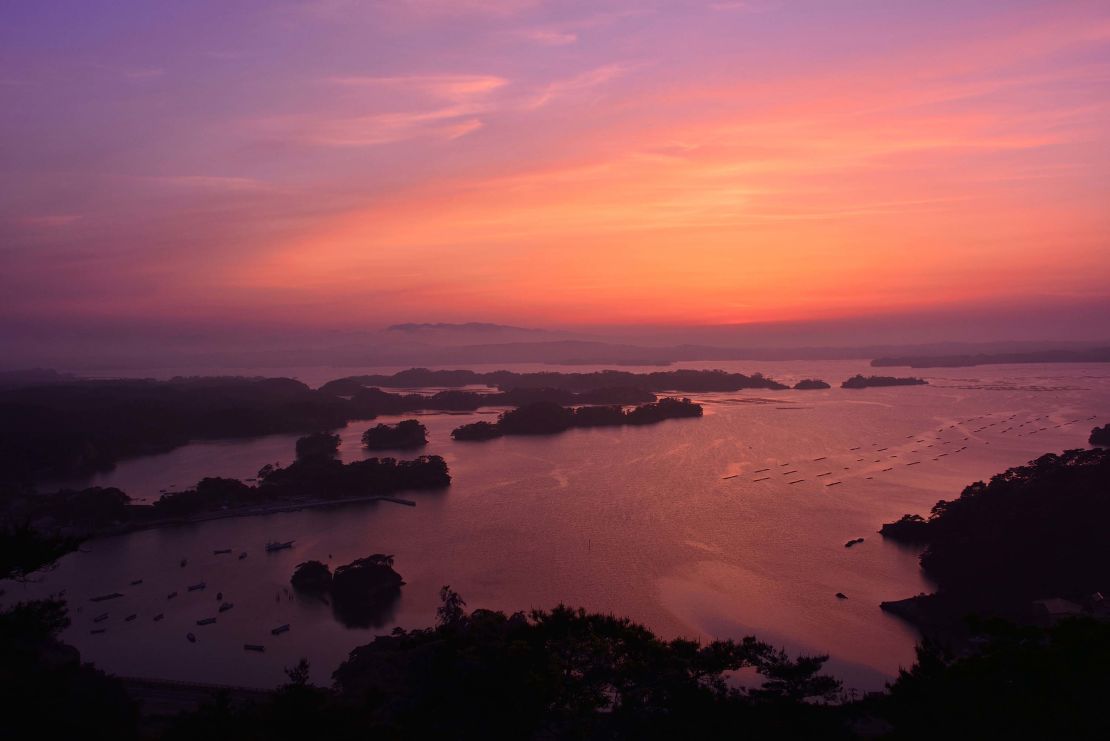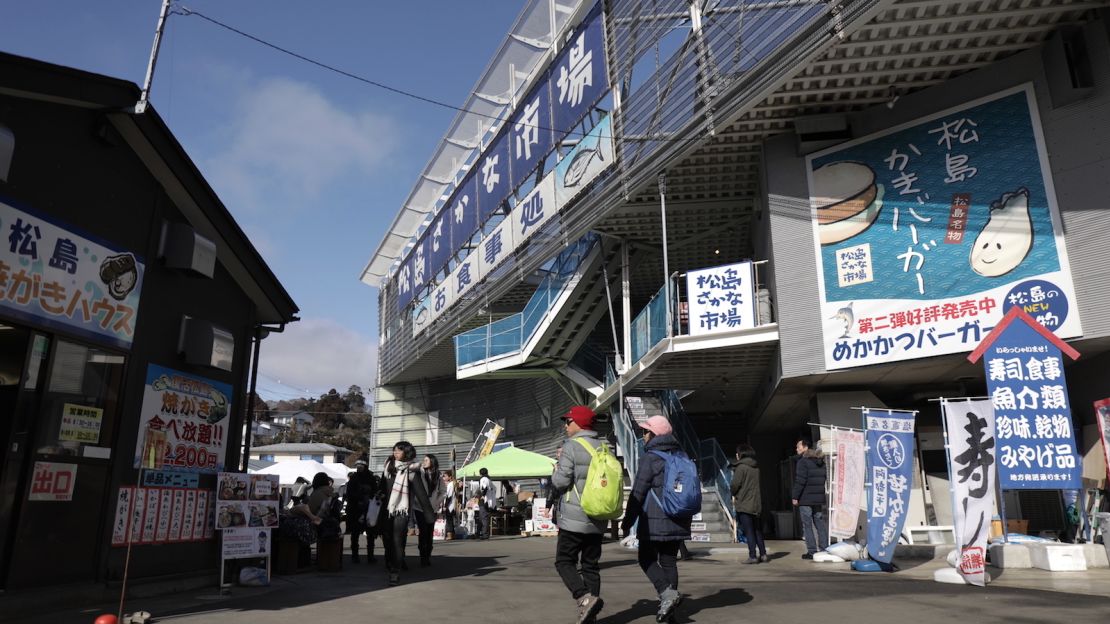It’s a chilly Saturday afternoon in February and temperatures are creeping just above the freezing mark – a time of year when most seaside destinations are devoid of leisure travelers.
But this is Matsushima, one of the fabled “Nihon Sankei” – or “Three Views of Japan” – and it’s buzzing with tourists.
Its fame dates back a few hundred years, to Japan’s Edo period, when a Confucius scholar named Hayashi Gahō traveled the country by foot.
In 1643 he published a book based on his journey in which he called out three destinations that, in his eyes, offered incredible scenic beauty – Amanohashidate, Miyajima and, you guessed it, Matsushima.
It’s easy to see why he deemed this little fishing town in Japan’s Miyagi prefecture as worthy of inclusion.
More than 260 tiny, pine tree-covered islands dot the waters of Matsushima Bay, creating a scene that’s been the muse of dozens of Japanese poets and artists through the ages.
More recently, in 2013 it was inducted into the France-based “Most Beautiful Bays in the World” club.
But the winter visitors we’ve spotted are not just here for scenic views. They’re more interested in the beautiful creatures being cultivated below the surface of the bay’s blue waters: Oysters.

It all begins with colliding currents
The window of opportunity to enjoy the region’s famed oysters is open from October to March.
According to award-winning author Hiroko Shimbo, an expert on Japanese cuisine who organizes culinary tours through the country, Miyagi prefecture is second only to Hiroshima in terms of both sales and volume of cultivated oyster production.
Without getting too scientific, there are a few reasons Matsushima’s oysters in particular are so prized.
“In the sea off Miyagi prefecture, a warm current travels north from Taiwan along the east coast of Japan,” Shimbo explains.
“A cold current that contains nutrient-rich water travels down the coast from north to south. The two currents collide at around the Sanriku area, which includes the coast of Miyagi Prefecture.”
The mixing of these currents leads to plankton blooms, which attract migrating fish.
“This same nutrient- and plankton-rich water makes Matsushima Bay oysters delicious,” she says, adding that wild oysters were first discovered as a culinary delight and harvested from Matsushima Bay back in the 17th century.
“After two centuries of intensive harvesting, fishermen found that the wild oysters were almost gone. Then the local government built a laboratory and began the study of cultivating oysters, collecting natural oyster larvae in water and then learning how to farm them under controlled conditions.
“By 1926 a complete system of oyster aquaculture was developed, and this resulted in the increased quality and production of oysters in the Matsushima Bay area.”

All-you-can-eat oysters
True obsessives head straight for the all-you-can-eat oyster shacks.
There’s one outside the Matsushima Fish Market; another can be found at the pier-side Matsushima Tourism Association Oyster Shack.
On weekends, these small buildings are crammed with mollusk-mad visitors.
Diners pay upfront and are seated at one of the many grilling tables. Armed with a knife, they toss on a glove and dive in, shucking then plucking the sweet, delicate meat from the shell with chopsticks.
Steam fills the space as staff make the rounds, piling the grills high with fresh oysters.
Prefer to eat your oysters raw? Head for one of the many restaurants in the town, which serve a variety of oyster-based dishes.
“Raw oysters are eaten just as is or served with ponzu sauce (soy sauce, mirin, yuzu citrus fruit juice) or with lemon juice and grated daikon spiced with red chili pepper,” says Shimbo.
“We also deep-fry them after dredging in panko bread crumbs. This dish, called ‘kaki furai’, is a popular lunch dish at inexpensive restaurants everywhere in the country. We also make a miso-flavored hot pot with oysters, called ‘kaki no dotenabe.’”
One Matsushima cruise company even runs special oyster hot pot cruises around the bay, allowing culinary tourists a chance to eat the delicious delicacies while taking in the area’s famous views.
Anything else to eat?

Can’t visit during oyster season? Matsushima’s got plenty of other seafood that will not disappoint.
“Seafood in the Matsushima area is considered of the highest quality because the seafood harvested in the area benefits from the nutrient-rich water and plankton found off its coast,” says Shimbo.
“In addition to oysters there are such local specialties as salmon, skipjack tuna (katsuo), Pacific pike (sanma), northern clam (hokkigai), asari clams, abalone (awabi), scallops (hotategai) and the best-quality wakame sea vegetable – don’t call it seaweed!”
The small but substantial Matsushima Fish Market is a fine place to kick off a culinary tour of the town.
You can order from a variety of vendors serving everything from ramen to sushi and oyster burgers.
Elsewhere, you’ll have no trouble finding a busy seafood restaurant serving local specialties. After dark, however, once all the day trippers have departed, things get really quiet.
There are a few restaurants open in the evening but we recommend heading for Isozushi (4-12 Isozaki, Matsushima, +81 22-353-2826), a gorgeous little sushi joint tucked down a small road about one kilometer from the fish market.
Run by a charming couple in their sixties, the restaurant’s menu is no frills, meaning the seafood is the star.
The pair can’t speak much English and there are no photos on the Japanese menu but if you just say “omakase” – which basically means “you can decide” – the chef will prepare a fantastic selection of local highlights for a decent price.
What else is there to do?
When you’re not busy eating, you’re going to want to spend some time exploring this walkable town and its famed bay.
Many travelers visit Matsushima just for the day from nearby Sendai – the capital of Miyagi prefecture – but it’s worth an overnight visit. There are a variety of inns and bigger, higher-end hotels. These include Matsushima Ichinobo, a large four-star property with lovely outdoor onsens (hot spring spas) overlooking the bay.
To truly appreciate Matsushima’s beauty, head straight for the shore near the Matsushima Kaigan train station.
Several islands are connected to the mainland by photo-worthy red bridges, such as the exquisite Fukuurabashi Bridge, which leads to Fukuurajima Island.
Home to more than 300 species of flowers, plants and trees, the island’s network of walking paths leads to several viewpoints. Tickets can be purchased at Cafe Bayland, which is connected to the bridge’s entrance.
Nearby, the beautiful Godaido Temple, founded in 807, sits on another small island that’s also connected to the mainland via a series of red bridges.
To explore further afield, cruises depart from Matsushima Pier every hour. The 50-minute tour takes travelers around the bay, passing islands and oyster farms. A prerecorded narration offers info on the area in both English and Japanese.
Tickets can be purchased in the bay, near the Fukuurabashi Bridge.
Other local attractions worth visiting include Saigyo Modoshi no Matsu Park (it offers great views of the bay) and a handful of picturesque temple complexes such as Entsuin and Zuiganji.
Getting there
Matsushima is located just under three hours by train from Tokyo Station. Travelers will need to transfer to the JR Senseki Line from Sendai Station and get off at Matsushima Kaigan Station, which is actually closer to the main sights than the main Matsushima Station.
Sendai Airport, about 40 kilometers from Matsushima, services direct flights from many Japanese cities as well as Seoul, Taipei and Shanghai.

















